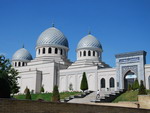In the beginning of the VIII century Arab tribes intruded to the territory of Central Asia. From years 709 to 712 the main of Maverannahr’s cities – Samarkand, Bukhara and Fergana went down one after another before the invaders. At that time a number of Chach’s cities, including its capital which bore the name of Madina Chach, were taken by assault. Once being prosperous, but now devastated by the Arab troops, the city was left in ruins when in the year 819 the Arab emir Yahya ibn Asad, the newly-crowned ruler, was sent there. The emir intended to build a magnificent city anew not far from the Chach’s ruins and declare it the capital. When Yahya ibn Asad was examining the outskirts he took notice of a high hill and announced to his attendants that it would be the place to start the erection of “Madina ash-Shash” (Shash city, Shashkent), the future capital. By the emir’s order a foundation for a Juma mosque was laid on the very top of the hill. This is one of the legends about the foundation of Tashkent. It was the foundation laid by the Arab emir that started the history of Juma Mosque of Khoja Akhrar Vali, which later on became the base of the Registan ensemble in the region of Chorsu square. This was the hill, mentioned in the legend, which in modern Tashkent is located in the triangle region formed by the squares of Chorsu – Khadra– Eski-Juva. But everything is in its due order, because indeed several centuries passed from the moment when the foundation was laid to the moment when the construction of Juma Mosque was begun. Khoja Akhrar Vali (born Ubaydulla al-Akhrari) (1404-1490), the Prophet Muhammad’s descendant, was a notionalist, great public figure, miracle worker and philanthropist. Alisher Navoi, the Khoja Akhrar’s contemporary considered him a talented politician. Owing to his efforts the enslaving tax in the territory of Maverannahr was abolished, and thanks to his wisdom a red battle between the troops of the Samarkand, Tashkent and Fergana’s rulers was prevented. Mosques and madrassahs in Bukhara, Kabul, Herat and other cities were built on Khoja Akhrar’s initiative. In 1432 Khoja Akhrar arrived on visit to Tashkent city and allocated money, which he ordered to use for building of the Juma Mosque. For this purpose, an ancient foundation destroyed under Yahya ibn Asad, and advantageously located on the hill so as it could be seen from a distance, was chosen to build it on. This was the way how the well-known Juma Mosque named after Khoja Akhrar Vali appeared in year 145 in Tashkent makhalla Gulbazar. It was a grandiose 15-m cube, symbolizing holy Kaaba, crowned with a dome. The mosque’s interior finishing was modest without rich decorations so that nothing could distract the faithful from their prayers. In course of time the Juma Mosque building had to pass through a good few of ordeals. A powerful earthquake of 1868 almost completely destroyed it but later on in 1888 it was renovated on the funds given by Alexander III, the Russian Emperor. That is why the Juma Mosque was called as an imperial mosque for some time. By the year 1997 the mosque sank into decay. That is why a decision was adopted to demolish those parts of the building that survived. A new mosque with three domes decorated in a modern style was erected on its former place. Due to all changes that took place, an idea of the initial appearance of the Juma Mosque of Khoja Akhrar was lost; it can be partially restored by few survived old photos. In spite of this fact, the new mosque built anew in the old part of the city is associated, as before, with the name of Khoja Akhrar. Up to date the architectural ensemble, surrounding the Juma Mosque of Khoja Akhrar Vali, except for the restored Kukeldash madrassah and Gulbazar makhalla’s mosque dome, did not survive either. The Juma Mosque of Khoja Akhrar Vali is a grandiose structure which concedes by its size only to the mosques of Bibi-Khanym in Samarkand and Poi-Kalyan in Bukhara. Furthermore it is the most ancient one among 157 mosques of modern Tashkent. Juma Mosque situated not far from the liveliest Tashkent bazaar Chorsu is one of the main embellishment of the old part of the city.
Tashkent HOTELS
Tashkent Guide
ADVANTOUR CONTACTS
- Contact Us
- Tel: +998 78 150 3020
- Fax: +998 78 150 3021


